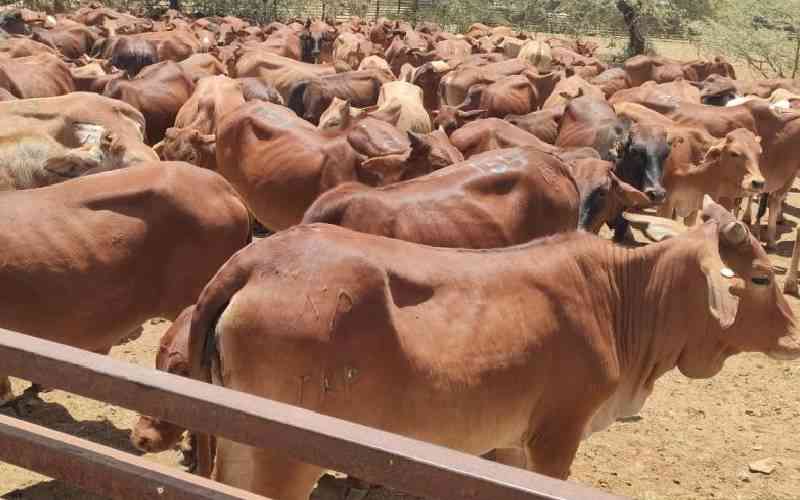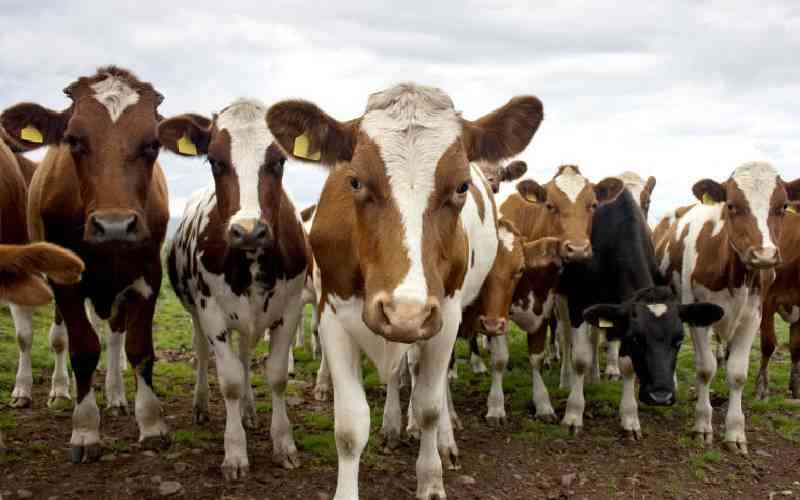I first came across a breed of cattle known as Fleckvieh when I was in vet school.
It has several positive attributes but what stood out for me is the fact that it is a dual purpose breed. Though this breed has been around for some time, to most dairy farmers it sounds like a new breed.
During the just-concluded Nairobi Trade Fair, while serving as an expert at the Smart Harvest stand, the enquiries about Fleckvieh were numerous. So today I will shed light on this breed that farmers in Western nations discovered ages ago.
Origin of Fleckvieh
This breed first emerged in the 19th century in the Kingdom of Bavaria in Germany.
The Fleckvieh resulted from cross-breeding of local German stock with Simmental cattle which were imported from Switzerland.
Since the Simmental had good milk-producing and draught qualities and with good muscle cover, the resulting crosses were triple-purpose animals with milk, meat and draught capabilities.
The Fleckvieh is now a dual-purpose breed; known all over the world and it may be used for the production of beef or milk, or be crossed with dairy breeds or with beef breeds.
In Kenya, farmers have not been keen on Fleckvieh since it is not very common in the farms but the interest has tremendously grown in the past few years.
Physical appearance
These cattle can easily pass for a Simmental breed; though Simmentals are purely beef animals. The Fleckvieh breed is huge with good muscle cover and a relatively big udder for females. Basically, the breed has light to dark yellow and red to dark red patches on white skin.
The distribution of colours may be spotted, speckled or most of the body solid coloured. The most important trademark of the breed is the dominant white head with a broad muzzle. Eye spectacles or eyelid pigmentations occur frequently. Belly, feet and tail are white, too. There are genetically polled and horned Fleckvieh cattle.
Production traits
The Fleckvieh is a dual purpose breed meaning it may be used for the production of beef or milk, or be crossed with dairy breeds or with beef breeds to get hardier animals and improve milk or meat production.
They are strong, fit and high yielding cattle. The ideal Fleckvieh cow in milk shows a strong forehead with a wide muzzle and maintains sufficient muscling on back and hind legs to keep stability and health even during peak lactation.
Stay informed. Subscribe to our newsletter
The body proportions are harmonious both when standing and in motion.
The udder is firmly attached and has an udder depth which remains above the hocks even after several lactations. Its reduced foot and hoof problems and reduced mastitis infections is due to proper udder carriage.
Milk production
Depending on management, natural conditions and feeding intensity herd performances vary between 7,000kg to 10,000kg of milk per lactation.
On first calving, Fleckvieh dairy cows can produce between 25 to 30 litres of milk per day.
On second calving, it produces 30 to 35 litres, increasing this to between 30 to 40 litres after the third calving. This production is usually almost consistent throughout the lactation period.
Their milk has 4.2 per cent fat and 3.7 per cent protein unlike the Friesian milk which has 3 per cent fat and 4 per cent protein per kilo. Fleckvieh milk also contains Omega 3 fatty acids — which are essential nutrients for human growth and immunity development.
The annual milk production increases per lactation, peaking at the fifth lactation. The breed has a more efficient feed conversion rate compared to other dairy cattle.
Research has shown that the breed can give more milk than other breeds with the same amount of feed. Fleckvieh calves weigh about 39kg and 41kg for female and males respectively. With high milk production and good maternal traits, the calves achieve high weaning weights.
Beef production
The breed has a medium to tall frame within the range of beef cattle breeds, being long with a wide and deep body suitable for beef production.
Male Fleckvieh calves grow fast and are suited for successful cattle fattening and provide dairy farmers with an important supplementary income stream.
Under intensive fattening conditions, young bulls reach daily gains of about than 1.5kg per day in males and 1.2kg in females for the first 200 days with a slaughter age of 16 to 18 months.
Culling cows reach a slaughter weight of 350kg to 450kg. Adult cows reach a height at cross of 140-150cm and a chest girth of 210-240cm weighing between 700kg to 800kg and the age at first calving is between 24 to 28 months.
Adult bulls weigh an average of between 1,100 kg–1,300 Kgs. In the western countries, the carcasses are on high demand since they are have a medium fat content and optimum marbling.
Disease resistance
Initially touted to be more disease resistant to infections like East Coast Fever (ECF) than other dairy breeds, this has been proven not to be entirely true.
Truth is due to their hardiness they can tolerate ECF better than other exotic breeds during infection.
Due to proper udder carriage, the Fleckvieh are not as prone to mastitis which is an inflammation of the organ that cuts down milk production.
Having thick skin, they also have a lower chance of suffering from vector-borne diseases such as trypanosomosis.
The breed has fewer lameness problems unlike other dairy breeds.
In summary, the Fleckvieh breed of cattle is hardy, has good muscle cover, faster weight gain, high milk production and can relatively withstand certain diseases.
This breed is suitable for production in the tropics where dairy animals’ nutrition is a big challenge. The breed is also recommended for beef ranching systems with supplementation, where they can be used as milk producers too.
Fleckvieh are available in Kenya although the demand for heifers and bull calves outweighs the supply. Imported Fleckvieh semen is also available for herd improvement in dairy and beef herds.
The cost of the semen varies depending on the bull of choice and whether the semen is sexed or not.
The writer is a Veterinary Surgeon, Faculty of Veterinary Medicine, University of Nairobi
 The Standard Group Plc is a
multi-media organization with investments in media platforms spanning newspaper
print operations, television, radio broadcasting, digital and online services. The
Standard Group is recognized as a leading multi-media house in Kenya with a key
influence in matters of national and international interest.
The Standard Group Plc is a
multi-media organization with investments in media platforms spanning newspaper
print operations, television, radio broadcasting, digital and online services. The
Standard Group is recognized as a leading multi-media house in Kenya with a key
influence in matters of national and international interest.
 The Standard Group Plc is a
multi-media organization with investments in media platforms spanning newspaper
print operations, television, radio broadcasting, digital and online services. The
Standard Group is recognized as a leading multi-media house in Kenya with a key
influence in matters of national and international interest.
The Standard Group Plc is a
multi-media organization with investments in media platforms spanning newspaper
print operations, television, radio broadcasting, digital and online services. The
Standard Group is recognized as a leading multi-media house in Kenya with a key
influence in matters of national and international interest.








